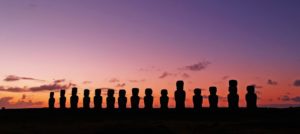
Easter Island is a Chilean island in the Pacific Ocean. It is located 3700 km or 2300 miles off the west coast of Chile, making it the most isolated inhabited island in the world. Since 1995 it has been a UNESCO world heritage site and much of the island is within a national park. The island has three names: Easter Island in English, La Isla de Pascua in Spanish and Rapa Nui in the local indigenous language. It is most famous for its giant stone statues which are called moai.
These statues are humanlike figures that were carved by local the indigenous people between the years 1250 and 1500. Most of them have large heads that represent almost half the size of the body and the faces are based on the ancestors of the indigenous people. They were carved from the volcanic ash found on the island. More than 900 of these statues are still located around the island, some in better condition than others. Creating them must have been a difficult task since they weigh an average of 12 tons each!
Easter island has been inhabited by Polynesian people who arrived in canoes sometime in the early 1200s. They created a prosperous society for hundreds of years and supported thousands of people. The first European visitor to the island was the Dutch explorer Jacob Roggeveen in 1722. As he discovered the island on Easter Sunday he named it Easter Island. In November of the same year, Spanish ships, under the command of Captain Don Felipe a González de Ahedo, made landfall on Easter Island. Unfortunately, many of the local people died of European diseases after first contact. Today the island has a population of approximately 8000 inhabitants and it has become a popular place for tourists looking for a unique experience.







